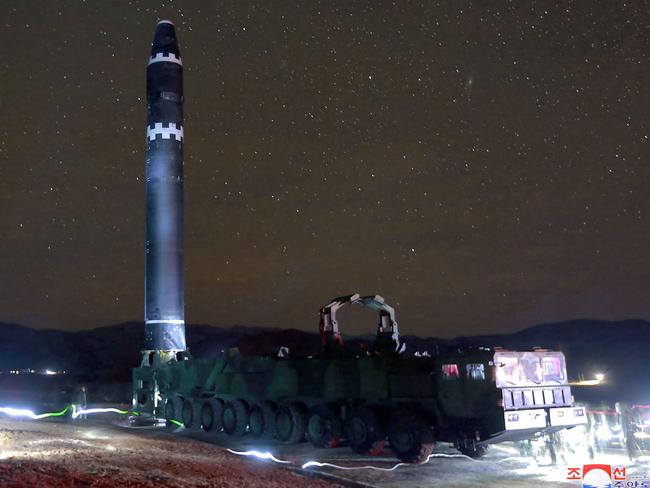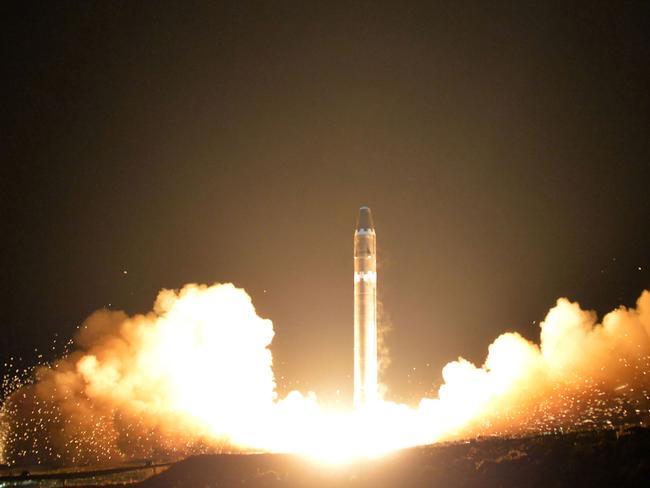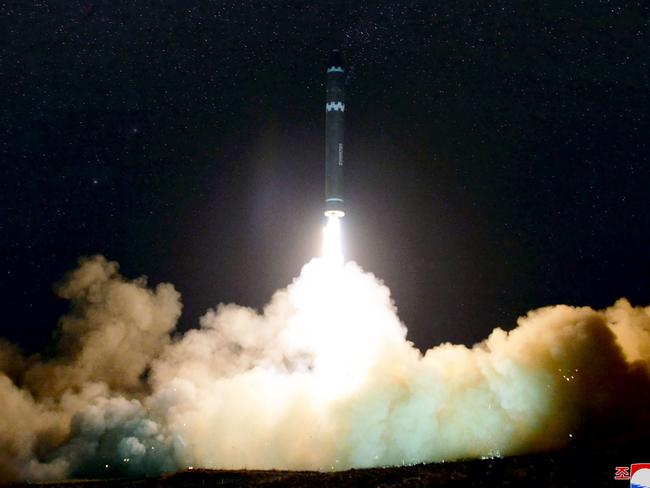North Korea missile: Were official photos tampered?
INCONSISTENCIES in photos released by North Korea after its latest missile launch have raised doubts among experts.
DIFFERENT star constellations shown in missile launch pictures released by North Korea indicate the secretive state has been tampering with the images.
Dutch space expert Dr Marco Langbroek pointed out how different the stars look in the pictures which are taken from opposite sides during last month’s missile launch.
In a series of tweets, and in his blog, Dr Langbroek writes how he worked out the direction of the photos based on the plumes of smoke coming from the rocket engine.
While not doubting the photos were taken just before and during the launch, he explains how he soon began noticing some inconsistencies.
So, I just discovered that the North Koreans DID tamper with their #Hwasong15 launch photo's! Two images from clearly same viewpoint, but dramatically different star backgrounds! Orion (Southeast) versus Andromeda (Northwest)! @planet4589 pic.twitter.com/ZzhFa3HwaM
— Dr Marco Langbroek (@Marco_Langbroek) December 4, 2017
Dr Langbroek was asked by Jeffrey Lewis, a nuclear weapons expert at the James Martin Centre for Nonproliferation Studies, to look into the images before and during the launch as part of the geolocation verification process.
“Take a look at the stars in the background: these then should show the same sky area, right?” he wrote on his blog.
“But they don’t!
“One shows Orion, which is south-southwest. The other shows Andromeda with the Andromeda galaxy (this is a bit more clear in a higher resolution version I have), which is northwest. So these two images from the same viewpoint, show dramatically opposite sky areas.”
Dr Langbroek goes on to explain how he found further evidence of tampring by looking at the exhaust plume and lack of number on the missile body in the second image.
More evidence of tampered #Hwasong15 imagery: two images, mirrors of each other (look at exhaust plume, lack of number on missile body 2nd image) so opposite viewpoints. Yet starfield in background both south-southeast, Orion and Canis major (but with Sirius missing!)@planet4589 pic.twitter.com/ZqfygbOwFa
— Dr Marco Langbroek (@Marco_Langbroek) December 5, 2017
Note: "southeast" in the image and tweet should read "southwest". It was after midnight and apparently I had a brainfart and wrote southeast while meaning southwest. https://t.co/AXYCYDEGu4
— Dr Marco Langbroek (@Marco_Langbroek) December 5, 2017
Dr Langbroek said not all the images released were altered and one shown just before the launch shows clear stars in the background and blurred people in the corner, indicating a long exposure was used.

Pyongyang fired the new model intercontinental ballistic missile (ICBM) on November 29 which it claimed was capable of hitting the eastern seaboard of the United States.
Kim Jong-un’s launch was the 20th such test this year and follows a 74-day pause in missile testing.
The missile flew for 53 minutes across 960km and reached a height of about 4500km. If shot at a normal trajectory, experts say it could reach as far as 13,000km, putting the US within range.
Dr Langbroek said it was clear the missile was real and the launch did take place.
However he points out the reason the North probably altered at least two of the images is purely down to looks or possibly to fool missile experts.
“The most likely reason is simply that they did it for aesthetics,” he writes.
“An ICBM soaring into the stars makes for good propaganda images. They apparently just didn’t care enough to do it correctly.”
According to Professor John Blaxland, director of ANU Southeast Asia Institute, such image alerting is consistent with North Korea’s past behaviour.
“This is altered but principally for aesthetic purposes,” he said.
The head of the Strategic and Defence Studies Centre also said the trajectory of the missile was corroborated by a range of sources so there was no question it took place, or that the missile is substantially larger and more capable than earlier versions.
“Appearances matter to Kim Jong-un, not just technical substance,” he said.

“But the substance is there, and in spades. The program has accelerated and the missile firing was incontrovertible proof that North Korea has outstripped the talk of disarmament.
“Cornered and under significant pressure from sanctions, but still without watertight border controls, Kim can be expected to continue apace.”
Dr Malcolm Davis, a senior analyst in defence strategy and capability at the Australian Strategic Policy Institute, agreed this didn’t mean the missile itself is a fake.
“It looks like they took two images — one of the night-time stars, using a long-exposure (with a guided tracking mount to avoid star trails) and one of the missile,” he said.
“I think that means they understand the effect of composition using Photoshop.”

DOUBTS REMAIN
Meanwhile South Korea’s Foreign Minister Kang Kyung-wha has revealed her country’s doubts over the North’s capabilities to deliver a nuclear warhead on an ICBM.
In an exclusive interview with CNN’s Christiane Amanpour, Ms Kang admitted the North’s weapons program had accelerated faster than expected.
However she said it has yet to prove it had mastered technical capabilities to fire off a nuclear warhead.
“They haven’t demonstrated their re-entry capability,” she said. “They haven’t demonstrated their remote targeting, or the miniaturisation that is required to do this.”
Doubts over North Korea’s capabilities come as one expert warns US President Donald Trump is playing a risky game that could spark an unintentional war.
Executive director of the International Institute for Strategic Studies office in WashingtoMark Fitzpatrick told Newsweek the Trump administration’s efforts to persuade China to do more to reign in its ally by cutting off its access to fuel could backfire.
“It is a risky game because the signals can easily be misinterpreted, particularly by the North Koreans, who may believe the US is intent to destroy them,” Mr Fitzpatrick said.
“They may therefore be inclined to fire first if they think an attack is coming. Comments that the potential for war is increasing could thus become a self-fulfilling prophecy.”



